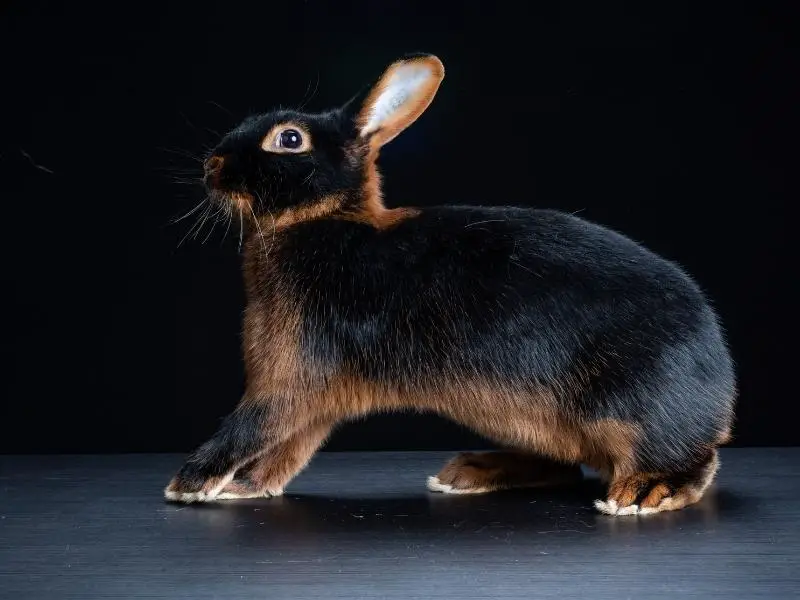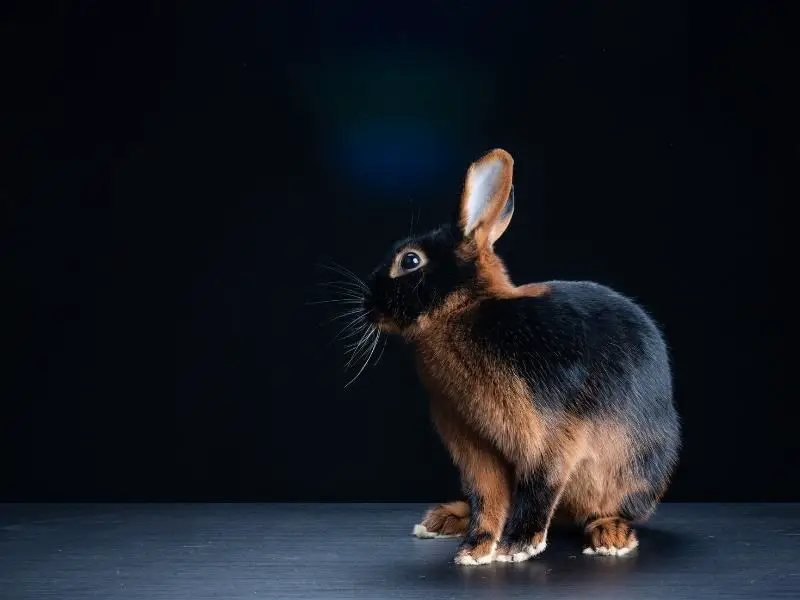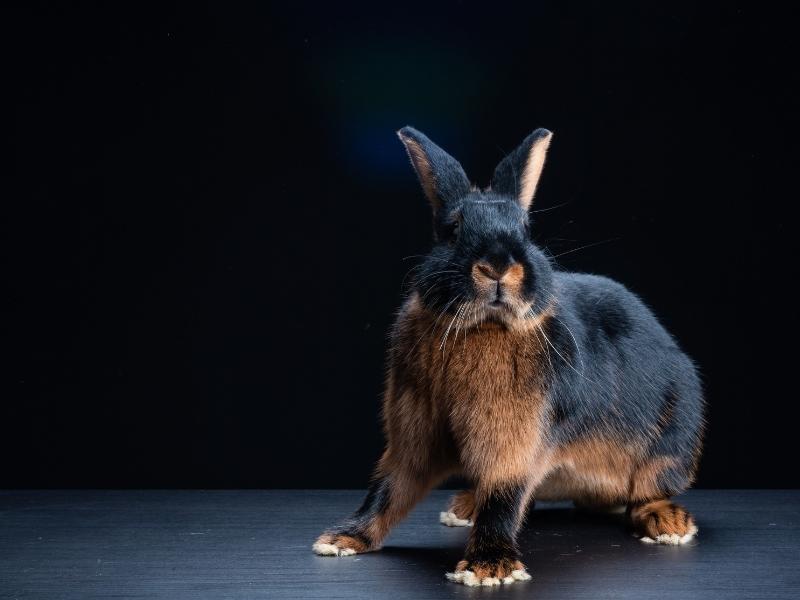Are you looking for your next show-winner rabbit? Or how about a small to medium-sized breed rabbit that has unique tan markings? Then the Tan rabbit is perfect for you!
What exactly is a Tan rabbit? Where did they come from?
A Tan rabbit originated in England when wild rabbits were bred with domesticated rabbits. As a result, these rabbits have tan markings on their ears, nape of their neck, belly, and tail, and the rest of their coat is dark. This fancy breed is energetic, smart, friendly, and sweet.
Let’s learn more about these cute Tan rabbits.
What Is a Tan Rabbit?
A Tan rabbit has unique tan markings on its otherwise dark coat that comes in 4 color varieties. This small to medium-sized rabbit breed is considered to be a fancy breed because these bunnies are mostly bred to participate in shows and exhibitions. However, they are also kept as pets.
With a lifespan of 8-10 years, keeping a Tan rabbit is a lifelong commitment.
Tan rabbits can be compared to the Thrianta rabbits or Harlequin rabbits.
The Tan rabbit is a fancy breed. They are kept as show rabbits, and they also make an excellent pet rabbit.
Tan Rabbit History and Origin
The Tan rabbit is an old domesticated rabbit breed. It’s been around since at least 1880 when the breed was discovered in England. Wild rabbits were bred with domesticated rabbits, and then after discovering the breed, breeders refined the tan markings on the Tan rabbit.
This breed was originally called the Black and Tan, and they resembled a Dutch rabbit with its cobby-style body. These days they have a lean body.
In the 1920s, the British recognized 3 color varieties of the Tan rabbit. These were lilac, blue, and black. Sometime between the 1920s and the 1940s, the breed was introduced in the United States.
In 1936, a specialty breeder’s club was created, but there was a lack of interest.
In the 1960s, the Tan rabbit breed was recognized in the United States, and the American Tan Rabbit Specialty Club was established; however, the Tan only became popular in the 1990s.
In 2003, a Tan rabbit won Best in Show at an exhibition, and this award confirmed the breed’s place as a show rabbit.
Tan Rabbit Characteristics

To identify a Tan rabbit, it should have these characteristics.
Appearance
The Tan rabbit has a fully arched body. The arch begins at the nape of the neck of the bunny, continuing all the way to their shoulders, midsection, hips, and bottom. When a Tan rabbit sits, you can see the floor between its foreleg and hindlegs.
This rabbit breed has a lean body that’s well-balanced. Their ears are straight and always stand tall atop their heads, making Tan look alert and intelligent.
The breed also has a small face that’s shaped like a wedge.
Adult male Tan rabbits generally weigh between 3.9-5.9 pounds, while the adult does weigh 3.9-5.5 pounds.
Coat
Tan rabbits have a flyback furry coat that’s glossy. As such, it doesn’t need a lot of grooming maintenance by you, the fur parent.
If your bunny’s coat is dirty, spot clean with cornstarch and/or a baby wet wipe. Never submerge a rabbit into the water to give it a bath; bunnies get scared easily and this causes it to stress. It could also lead to a heart attack and death.
These rabbits shed or molt about twice a year, so this is the only time when you’ll need to groom more often.
Groom your rabbit with a rabbit-friendly comb or brush twice a week; this will reduce how many loose fur tufts you’ll find on your clothes and around your house.
Color Varieties
If you are into breeding Tan rabbits, then you’re in luck. Every kit will have the same coloring like that of its parents. Thus, the kits – when mature – should be show-worthy.
Tans have a dominant agouti coloring where you can see the tan coloring and a recessive self-alleles coloring on top where the darker coat coloring will be more dominant.
A Tan rabbit should have a red-orange highlight pattern; the rest of the dark coat can be black, chocolate, lilac, or blue.
The original Tan has a black coat with red-orange markings. The next color variety was blue, and then in the 1920s, breeders bred Tan rabbits to create a chocolate tan. Shortly after that, the lilac Tan was bred.
You’ll see the dark coat on a Tan rabbit’s head, sides, and back. The unique markings in tan coloration are found inside the ears, nostrils, jowls, around the eyes, and on the underside of the chest, tummy, and tail. The nape of their necks is also tan.
The tail actually has a three-color marking – dark where it meets the body, then tan, and finally a much lighter shade of tan.
Temperament
The personality of a Tan rabbit can be summarized as friendly, energetic, sweet, and intelligent.
As such, these bunnies make great pets, even though they aren’t very affectionate.
While they tolerate their fur parents, they prefer to not be petted and cuddled for long periods or at all. This isn’t the rule, and your Tan rabbit might be super affectionate, especially if you handled them often from birth.
Tan rabbits are very energetic, so they may not make the best pet rabbits for seniors or very young kids. They may be difficult to catch if you need to get hold of Mr. Fluffles.
These bunnies also need a lot of exercises, so their run needs to be quite large.
Tan Rabbit Care

Here’s a care guide to help you take good care of your Tan rabbit:
Cage and Habitat
The first Tan rabbits were originally from England, and they had to learn to adjust to a lot of wind and rain. As such, these rabbits are better suited for cold weather than for extremely hot climates.
Some rabbit owners recommend a hutch that’s 3 square feet; however, this doesn’t include the run for your bunny to get enough exercise. Work on an enclosure and run off at least 12 square feet per rabbit.
A Tan rabbit can live either indoors or outdoors. If you house your Tan outside, ensure the enclosure is weather and predator-proof.
Raise the wire or wooden hutch off the ground as this will help keep your bunny safe. Indoor cages can be made from wire and ensure there’s a solid bottom so you can add some hay or newspaper bedding for your bunny.
Remember to clean the enclosure every day, whether your rabbit lives inside or outside.
Diet
Just like for other pet rabbits, a Tan’s diet should consist of 70% good-quality hay. Chewing on hay all day ensures your rabbit’s teeth don’t become long and overgrown. Overgrown teeth lead to all sorts of health complications and expensive visits to the vet.
The remaining 20-25% should be leafy green veggies, while a minor part of their diet will be treated in the form of pellets, root vegetables, and fruit.
Ensure your rabbit has a healthy and well-balanced diet, as this will help ensure they live a long life.
Your rabbit should also have enough clean, freshwater every day.
Health
Generally, the Tan rabbit breed is healthy. These rabbits, like others, can be affected by mites, fleas, and ticks. To prevent these insects from making your rabbit their home, ensure your rabbit’s enclosure is clean.
While Tans are healthy, they aren’t immune to common ailments that affect domestic rabbits. As such, it’s essential to keep a close eye on your bunny and address any health concerns sooner rather than later.
Also, deworm your Tan at least yearly, or during spring and fall if possible. This will ensure a healthy digestive system and relieve them of any worm burdens.
Breeding Tan Rabbits
Tan rabbits are a fancy breed, meaning they are mostly bred for shows and exhibitions. However, these bunnies make great pets too!
As Pets
As Tan rabbits became more popular in the show and exhibition world, their popularity as pets also increased.
A Tan rabbit needs a moderate amount of care and their personality makes them well-suited for rabbit owners who are single or have a family with older kids who can run and play with their rabbits.
For Shows and Exhibitions
In 2003, a Tan rabbit won the Best in Show category at the American Rabbit Breeders’ Association Convention. This was a very prestigious award for this rabbit breed and set them on the map as show rabbits.
Tan rabbits are also a moving breed, so they do well in rabbit agility and sports like hopping.
Tan Rabbit Price
The cost of a Tan rabbit depends on whether you just want a Tan as a pet or if you are looking for a Tan from a proven show bloodline.
For a general Tan to keep as a pet, you’ll pay anything between $30-75; however, if you are looking for a Tan for exhibitions and shows, you’ll probably pay between $200-400.
The least expensive option would be to adopt a rescue rabbit, and you’ll pay as little as $10 for a rescue Tan.
Conclusion
Tan rabbits are great rabbits to have as pets or for show.
With a well-balanced diet, proper care, and lots of exercises, your Tan can live for at least 8 years, if not longer.

